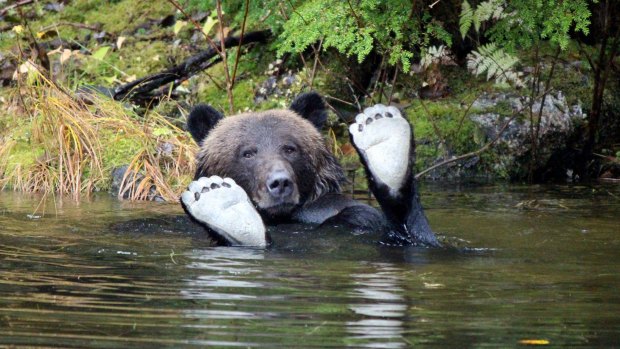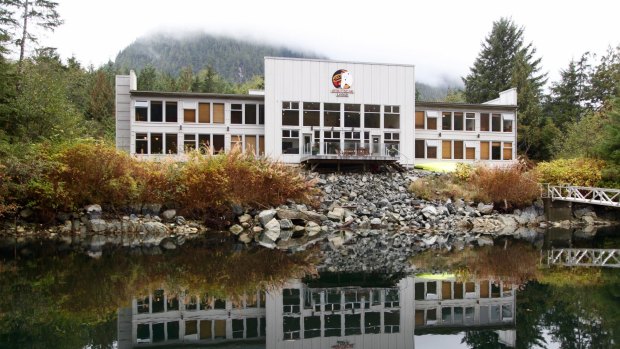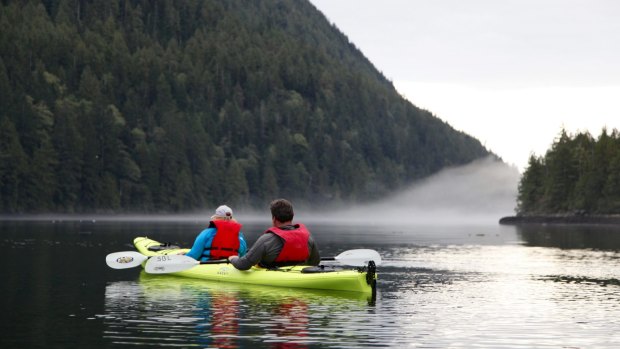This was published 8 years ago
Great Bear Rainforest, British Columbia: Seeing bears in the wild in Canada

A bear enjoys a dip in a waterway in the Great Bear Rainforest.
The black bear picks her way across the fallen log, one lumbering paw after the other, head down, eyes scanning the river's edge. Below, the water is a ribbon of mercury, slippery with salmon making their fateful journey upstream, while overhead jagged peaks scratch at a leaden sky. At her heels two smudges of black; teddy bear toys in a forest of green.
Holding my breath I watch as she nudges the cubs towards the nearest crab apple tree, pushing them high into the branches for safekeeping, their curved claws adapted for just this task.
It's all I can do not to laugh, the cubs' slumped shoulders signalling they are none too happy with this aerial daycare arrangement.

Spirit Bear Lodge at Klemtu.Credit: Kerry van der Jagt
Sitting here, off the coast of British Columbia, in the midst of the Great Bear Rainforest, in one of the largest unspoiled temperate rainforests on earth, I feel the deep-seated bliss that comes from such wildlife encounters, as if everything I've done before has led to this moment. As if all the pieces of myself have come together. I exhale, a cloud of mist giving up my location like a smoke signal. "Don't worry," my nature guide Christopher Arends whispers, "she knew we were here before we even stepped ashore."
Initially I was fixated on seeing a spirit bear, but gradually, through the wisdom and grace of the Kitasoo/Xai'xais guides I'm gaining a feel for the spirit of the entire forest. A fragile place of furious extremes, where wolves swim between islands snacking on seafood, cedar trees stand for a 1000 years, sea lions dance in the shallows, and sometimes, black bears are white.
Numbering as few as 100, the white Kermode bears are not albinos or polar bears, but rather a variant of the black bear, rendered white due to a recessive gene. To scientists, the mutant gene, found only in one in 10 black bears and almost exclusively here in the Great Bear Rainforest, is possibly an 11,000-year-old throwback to the last ice age. To the Kitasoo the white bear is Moksgm'ol, or spirit bear, the most sacred animal in the forest. Legend holds that Goo-wee (Raven) made black bears white to remind people of the time when the land was covered in glaciers.

A late afternoon paddle from Spirit Bear Lodge.
Getting here is an adventure in itself – a flight from Vancouver to Port Hardy, another one to Bella Bella on Campbell Island, an overnight stay at Shearwater followed by a two-hour boat trip to Swindle Island. Skippered by "Moose" we'd cruised through glacier-fed fiords, navigated a jigsaw of islands, passed breaching humpback whales and basking sea otters, and finally, reached the community of Klemtu, home of the Kitasoo people.
Our base camp for the next three nights is Spirit Bear Lodge, an ecotourism venture owned and operated by the Kitasoo/Xai'xais First Nations. While the waterfront 12-room lodge is comfortable and well appointed, a trip to the Great Bear Rainforest is not about luxury. Nor is it about producing wildlife "on demand", or purpose-built viewing platforms or "scouts" radioing ahead about sightings. In fact, sightings are never broadcast as hunters could be listening – yes, it's that kind of place. It's a place where rainfall is measured in metres, not millimetres and guides carry pepper spray, not guns. "These creatures are our family," Moose says. "The old people say that everything we learned about the forest we learned from the animals."
It's early October, the coastal rivers are thrumming with Pacific salmon and the bears have long left their mountain dens for the annual riverside picnic. After transferring to zodiacs we slip into Mussel Inlet, a lone raven signalling our arrival. Dressed in oversized rubber overalls, jackets and boots, it feels like a mission to Mars.
Single file behind Arends we wade ashore, pick our way across the boulder-strewn intertidal zone and are soon swallowed by the forest, tendrils of old man's beard lichen closing behind us. Originally from Vancouver Island, Arends has been made an honourary Kitasoo for the work he has done to help the First Nations people. At intervals he points out scratch marks, rub trees, even a den carved out of the roots of a cedar tree. I shiver. It's hard not to be scared, even though logic tells me these well-fed salmon bears have little interest in humans.
Taking up position by the river we watch the black cubs in the crab apple tree before a mother grizzly and her offspring come down. "I've been watching this mum and three cubs for the last three seasons," Arends whispers, pointing to the opposite riverbank. "One day she brought them across the river, trusting me to watch them while she went fishing."
To ensure this trust, which has developed over thousands of years, is maintained, the First Nations people do not permit invasive research practices such as capturing or tagging. Instead, the Kitasoo/Xai'xais people, through the Spirit Bear Research Foundation and Spirit Bear Lodge, collect passive data such as bear hair from snags or movements via remote cameras.
Arends talks about the grizzly cubs as if they are his children, telling the story about the time a male charged him, and how the mother intervened, reprimanding the overzealous youngster. "They are like preschoolers," Arends says, shaking his head. "Everything is a game."
But it's not all fun and games in the forest, a dark cloud is looming – the proposed Enbridge Northern Gateway pipeline. In 2013 a Canadian government-appointed panel recommended the approval of the pipeline, which would bring crude oil extracted from the Alberta tar sands to the Asian market. A route that would lead to hundreds of tankers passing through the heart of the Great Bear Rainforest, long considered one of the most treacherous sea passages in the world. Hope now rests on newly elected Prime Minister Justin Trudeau to take a stand.
Later that night, gathered in the communal lounge, we listen to Philip Charles, a lead guide who holds a degree in animal conservation and is also an honorary Kitasoo, talk about the "Watchmen", a stewardship program where First Nations people camp out in the forest for months, monitoring resources, enforcing management plans and looking out for poachers or hunters. It is a grim reality that blacks and grizzlies are still killed by hunters with permits issued by British Columbia's Ministry of Forests, Land and Natural Resources. And while it is illegal to kill a Kermode, it's impossible to know which black bears are carrying the recessive gene. Bear "tags" are lucrative for the government, with numbers controlled by a lottery system. "For a Canadian a bear tag costs about $100," Charles explains. "But an international visitor will pay tens of thousands of dollars." I learn that up to two dozen bears are killed each year – trophy hunters want paws and heads, poachers want livers for the Chinese market. First Nations people want it outlawed."
Charles also works with local teenagers on a program called SEAS (Supporting Emerging Aboriginal Stewards). "These kids are the next chiefs and policymakers," he says. "We are helping them to maintain culture for future generations." Later we are invited to the "big house" to watch an impromptu performance, where, through dance, music and storytelling we are introduced to the Kitasoo concept of shape-shifting, where humans and animals swap forms, and also to Raven, the creator of all things.
The following morning a 90-minute boat ride brings us to Kynoch Falls where Jaylen, one of the Watchmen, shows us petroglyphs high on the walls of a chasm. 'We must come into Kynoch sneaky," Jaylen warns. "This area was once hunted out and the bears remember." Standing on the back of the boat, rain shooting like falling stars, he shares his family's "copper shield" story with us. Pointing to the three figures in a canoe he tells how his ancestors gave their power to another band in return for freedom, and that to this day the copper shield is passed down through women, with Jaylen's grandfather's sister the current caretaker of the story. Here, among the spirits of the forest I feel my own grandmother, matriarch and grand storyteller of my family.
On another day we take to the water in kayaks, nuts and fruit squirrelled away in our waterproof packs we push off from the lodge to paddle to an ancient burial island, eyes scanning the riverbank for movement or colour. It is the tail end of season and although there have been no white bear sightings for the last week, no one is disappointed. "The bears will show themselves when you are ready," Moose had told me.
On our final day we travel by zodiac into Canyon Creek, the sky, land and water a single canvas of grey. For two hours I sit on a boulder and watch, and wait. Then I see her, a black bear on the opposite bank, entering the water, her strong paws cutting through the current, snout aloft, breathing in my presence. My smell now a part of her memory. Forever.
Then, her cub appears, bounds into the water to meet her, nuzzling her shoulder, almost crying with joy. I too am crying, as the pair turns and disappears into the forest, their spirits now a part of me. Forever
TRIP NOTES
MORE INFORMATION
GETTING THERE
Air Canada flies daily from Sydney to Vancouver in British Columbia. Melbourne passengers fly to Sydney for connections. See aircanada.com. Pacific Coastal Airlines flies daily from Vancouver to Bella Bella, via Port Hardy. See pacificcoastal.com
STAYING THERE
Spirit Bear Lodge offers three, four, five, six and seven-night packages from June 1 to October 10. Four days/three nights (including first night at Shearwater) ex Vancouver costs from $3457 per person, twin share including return airfares from Vancouver to Bella Bella, roundtrip water taxi from Bella Bella to Spirit Bear Lodge, full board with daily activities, house wine with dinner and services of local guides. See spiritbear.com or naturalfocussafaris.com.au
The writer was a guest of Spirit Bear Lodge and Destination Canada
Sign up for the Traveller Deals newsletter
Get exclusive travel deals delivered straight to your inbox. Sign up now.